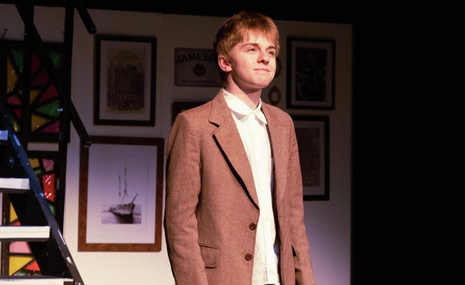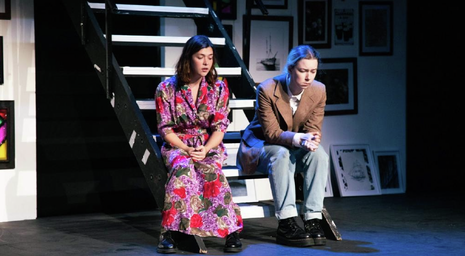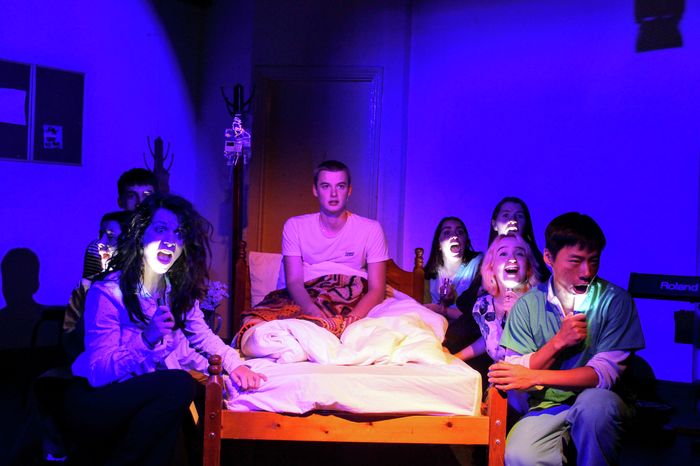In Our Veins: when it works, it works well, but these points are rare
The failing here is one that cannot be remedied in the acting alone: it is in the format of the script

In our Veins, written in 2019 by Dubliner, Lee Coffey, is a sentimental love poem about the history of grit and grime that makes up the writer’s hometown. Coffey ambitiously attempts to imitate what Dickens achieved for London. But, unlike the famed writer’s works, Coffey’s disjointed and difficult script pulls many of its punches, and struggles with some of its darker themes. This leaves the director and cast unable to present a fully impactful performance, despite some poignant moments.
The play begins with the death of the central character, docker Patrick Doyle (nicknamed ‘Little Paulie’) surrounded by his family. Esther, his wife, is then moved to tell her family a tale that has previously been kept secret.
The play explores Dublin’s history through this family’s eyes, in two distinct tales. First, we are taken to the horrors of Dublin’s Monto, the city’s notorious red-light district, into which poor country girl, and Patrick’s mother, Anne Brady, falls.
This section of the play is the weakest, but that is by no means due to the acting of Grace Heslin, who delivers an engaging and memorable performance as Anne. She captures the nervousness and naïveté of her character wonderfully and has one of the more convincing Irish accents of the cast (some of which were prone to slipping).
The failing here is one that cannot be remedied in the acting alone: it is in the format of the script. Anne tells us the story in an almost entirely expositional style, with little action being shown. At times, this feels like a potted history rather than a performance, as if the character were reading her life from the pages of a history book, rather than truly living it—the writing advice ‘show, don’t tell’ springs to mind.
Unlike the second half of the show, which largely features Christian Longstaff, Jake Turner and Sarah George in a trio, Heslin is noticeably unsupported as she reveals her character’s trauma. Her extended monologues, although well portrayed, are not enough on their own to be truly moving.

Georgina Manley’s May, a madam described as two sides of a coin – ‘devil on one side, a saint on the other’ – and the main antagonist, lacks venom. Her treatment of the characters seems muted, the depths of her horrific actions not fully realised. As the epitome of immorality in the Monto, May’s lack of bite lessens the horror of the district. If May is the worst the Monto has to offer, it really doesn’t look so bad.
The second half of the play, following Patrick Doyle (little Paulie), his father, and the docker Bloody is more successful, with actors and audience alike seem more settled. The easy banter between the trio is entertaining, and the direct audience addresses the briefer, although not entirely absent.
Coffey’s writing excels in the docklands – possibly revealing a greater connection with the subject matter. The action is more brutal, and the themes may be violent, but they are straightforward and open. It is disconnected from the more ambiguous, sordid first half, and better understood by all.
Longstaff’s performance is particularly notable, and he often lifts scenes. His characters are both wide-ranging and convincing. The moments between Esther (Meg Reynolds) and Patrick (Longstaff) were some of the best of the play, with their clumsy, romantic beginning being both touching and very funny.
Unfortunately, the ending falls down again, with the expositional style returning in full force for the final moments. What should have been a sensitive and emotional ending is rendered farce-like in its simplicity.
Ultimately, this is a very difficult play to stage well, and the performance has some great moments. When it works, it works well. But unfortunately, these points are rare.
In Our Veins is showing at 7:45pm from Tue 18th-Sat 22nd October in the ADC Theatre
 News / Cambridge bus strikes continue into new year16 January 2026
News / Cambridge bus strikes continue into new year16 January 2026 News / Local business in trademark battle with Uni over use of ‘Cambridge’17 January 2026
News / Local business in trademark battle with Uni over use of ‘Cambridge’17 January 2026 Interviews / The Cambridge Cupid: what’s the secret to a great date?14 January 2026
Interviews / The Cambridge Cupid: what’s the secret to a great date?14 January 2026 News / Uni members slam ‘totalitarian’ recommendation to stop vet course 15 January 2026
News / Uni members slam ‘totalitarian’ recommendation to stop vet course 15 January 2026 Science / Why smart students keep failing to quit smoking15 January 2026
Science / Why smart students keep failing to quit smoking15 January 2026










